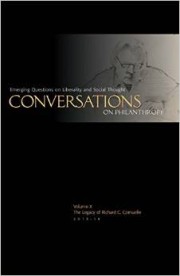Empowering, Not Enfeebling: Beyond the ‘Market V. State’ Dichotomy
“Honor donor intent” is one of the main articles of faith in the philanthropic community. Without a doubt, contractual stipulations of donors are and should be binding, but it is important to recognize that philanthropies and other nonprofits are organizations in their own right, and respond to incentives and to institutional arrangements in ways that may have unintended consequences. In this essay I consider three phenomena: crowding out, crowding in, and incentives that are coercive. Ultimately I advocate a more cautious approach to trying to “make a difference.”
The question is misleading, and intentionally so. Philanthropists have objectives; donors have objectives. Communities have needs. And the particular needs of communities that get served may depend on the objectives of donors and philanthropic organizations. There is little reason to believe that the needs that a given community sees as most pressing are related to goals that donors see as most interesting.
What are the objectives of philanthropy?
There may be nothing wrong with that, of course. There are many organizations in government and the nonprofit sector that look to answer unmet needs. But there is a general trend in philanthropy to morph from (a) discerning and answering needs of a community to (b) redefining problems in more general and abstract terms to (c) attempting to centralize direction and control of philanthropic enterprise and solve problems at the level of the logic of system rather than the needs of people. In these reflections I consider some of the causes and consequences of that transformation. The business of philanthropy, as a general matter, is a combination of brokerage services—linking donors with needs—and management and execution—spending money in ways that advances the purposes of donors. An increasing trend, at least in terms of the size of the operations and activities being funded, might be called “scientific philanthropy” (see, e.g., the discussion by Ealy, 2014). This “evidence-based philanthropy,” or the “Money Ball approach” to giving, may not be entirely new, but is in some ways a harkening back to the ambition of the Progressive Era. As Ealy (2014) puts it:
Scientific philanthropy arose out of the charity organization movement as an effort to bring the tools of scientific expertise to the social problems of rapidly urbanizing and industrializing societies. Scientific philanthropy departed from traditional forms of charitable relief, such as direct material relief and mutual aid, in favor of research to discover the root causes of social problems. These causes were often found to be some moral deficiency of the person in need of aid, and so Progressive philanthropy helped forge a “problem-industrial complex” which united the forms of Protestant morality with the agencies of institutional social control, especially through public education and the burgeoning administrative state (87; emphasis added).
My subject here is putting this notion of philanthropy, as an activity focused on the goals for funders, possibly at the expense of the goals of those being “helped,” in a broader context. It is interesting to think of philanthropy as a business, an enterprise. Taking a step back this way provides us some analytical tools that may help us recognize some directions that philanthropy might take, and highlight some problems that we may be able to avoid.
Beyond the Public/Private Dichotomy: Philanthropy as Enterprise
We often consider the problem of organizing groups of people in terms of binaries: public vs. private; states vs. charities; coercion vs. voluntary action. But it’s rarely that simple. Modern philanthropy is a business. It’s a business with goals, and methods, and institutional structures that are quite different from for-profit businesses, but it’s a business nonetheless. And in the last couple of decades, a wide variety of philanthropic enterprises have re-targeted. They have become weapons of mass instruction.
H.L. Mencken famously evaluated the “executive secretary” of the Progressive Era philanthropic organization. The satire is, I think, uncharitable. And yet it is hard not to recognize at least several grains of truth, if not in your organization, than certainly in some others of which you have heard rumors.
The executive secretary is relatively new in the world… He belongs to the order of live wires. He speaks the language of up-and-coming men, and is not sparing with it at the sessions of Rotary and Kiwanis. In origin, not uncommonly a shady and unsuccessful newspaper reporter or a press-agent out of a job, he quickly becomes, by virtue of his craft, a Man of Vision. The cause that he represents for cash in hand is not merely virtuous; it is, nine times out of ten, divinely inspired. If it fails, then civilization will also fail, and the heroic doings at Chateau Thierry and Hog Island will have been in vain.
It is a good job that he has…There is no need to get up at 7 A.M. and there is no need to fume and strain after getting up. Once three or four—or maybe even only one or two—easy marks with sound bank accounts have been snared, the new “national”—or perhaps it is “international” association is on its legs, and all that remains is to have brilliant stationery printed, put in an amiable and sightly stenographer, and begin deluging bishops, editors and the gullible generally with literature… Once a year he launches a drive. But it is only for publicity. The original suckers pay the freight (2010, 522).
Of course, the “executive secretary” of Mencken’s day has been promoted, and is now an “executive director.” We might also call this person an entrepreneur, of course, but outside the for-profit world entrepreneurship can have different tactics, and consequences.
Revenue still has meaning in the philanthropic enterprise, of course. The money an organization raises from foundations, or donors, may be an important objective for public charities. Even for private foundations the revenue earned from the endowment is of crucial importance. “Operating foundations” fund and direct programs directly, while non-operating foundations provide funding for other organizations, often in the form of grants. All of these organizations are formally “nonprofits,” of course, but that doesn’t mean that they are run for the benefit of anyone except the donor(s) and the management of the organization. There are no stockholders to please, and no stock price to serve as a metric of the organization’s success, or failure.
Eugene Fama, winner of the 2012 Nobel Prize in economics, wrote a series of research papers with Michael Jensen (1983a; 1983b; 1985) outlining the logics of nonprofit organizations. Their work is essentially a wrinkle in the problem of separation of ownership and control, with the difference being that for nonprofits “ownership” is either the document specifying donor intent (for a private foundation) or the dual legal responsibilities to adhere to both the organization’s educational, scientific, or charitable purpose and the express intent of contributors (for a public charity). “Control” is then exercised by the organization’s board, or (in at least some cases) by the executive director. All of which raises the question of whether donor intent, board intent, or the discretion of the executive officer should drive the operations of the nonprofit.
The argument is rather involved, but Fama and Jensen summarize their conclusions in a later paper:
When the activities of an organization are financed in part through donations, net cash flows are in part due to the resources provided by donors. Contracts that define the share of residual claimants in net cash flows are unlikely to assure donors that their resources are protected against expropriation by residual claimants. Our hypothesis is that the absence of residual claims in non-profits avoids the donor-residual claimant agency problem and explains the dominance of nonprofits in donor-financed activities.
Given that there are no residual claimants in non-profits, there seems to be a puzzle about whose interests are to be satisfied in resource allocation decisions… Without the analytical crutch provided by residual claimants, criteria for optimal investment decisions in non-profits must be viewed in terms of the more general competition for survival among non-profits and between non-profits and other organizational forms that could engage in the same activities.
The key to the analysis is in the economics of donations… Donations can mean that a non-profit survives even when it is otherwise less cost effective than a for-profit organization in the production and delivery of the goods and services demanded by customers (1985, 115; emphasis added).
Suppose that the donor’s (or donors’) intent is clear. Is an honest adherence to donor intent sufficient to guarantee that the foundation is benefitting the public? Suppose that the donor’s intent is vague, or ambiguous. Is divining donor intent necessary to ensure that the foundation is benefitting the public? And in either case how can the legislature be reasonably certain that nonprofit “exempt” (US Code 501(c)) status is being conferred on an organization that justifies such insulation from property taxes and taxes on income?1 The problems explored by Fama and Jensen are not so very different from those satirized by Mencken: the nonprofit form is useful as a means of raising funds through donations, either in the foundation form of endowment or the public charity form of attracting annual operating funds, but the absence of an obvious product or a residual of revenues over costs means that it is difficult to measure the efficiency or effectiveness of a particular nonprofit organization. In fact, scrutiny is often restricted to ensuring that the organization spends the required amounts, and that the spending can be demonstrated to have been devoted to the required purposes.
But what might the funds have been spent to try to accomplish? Donor intent might plausibly be directed at one or more of the following:
- A perceived need of the relevant community or population
- Doing “good”
- Spending our budget, subject to constraints
- Attracting donations
- Multipliers, especially leveraging with matching funds from other organizations or through public-private partnerships
Note how these goals seem innocuous. In many ways, to be fair, they are innocuous: How could anyone quarrel with “donor intent” as the basis for goals of the nonprofit?
The problem is that the goals of organizations can evolve over time in ways that may be hard to see from the inside or from the outside. I may be one of the few people in America with simultaneous membership in two particular organizations: The National Rifle Association (NRA) and The American Civil Liberties Union (ACLU). I get lengthy letters from each, at least once a month, detailing how evil people (including, for the ACLU, the NRA, and vice versa) will soon destroy the very fabric of society. Public charities are in constant danger of succumbing to the very real temptations to maximize net revenues, just as if they were a for-profit firm. The difference is that public charities are selling their donors a chance to feel good about themselves, to participate in righting a wrong, and so the advertising often focuses on outrage, and fear, and misrepresents the positions and questions the motives of “the bad guys.”
I’m not making a partisan point, mind you, but an organizational point. A public charity may start with some goal that involves helping the needy or improving public policy. And donations are a means to that end, to be sure. But fairly soon in the historical path of the organization, donations may become the ends, and the activities of the organization become simply the means to increase donations. We tend to think that this sort of “consumer sovereignty” is at least tolerable in private markets, because consumers are receiving physical goods and services, things whose quality they can judge, at least after the fact. But if a public charity uses its advertising and activities primarily to maximize donations then it is no longer clear that any real public purpose is being served.
An analogous problem, though different in detail, can occur with foundations. Foundations don’t rely on donations, for the most part, so they don’t distort their missions in that way. But if a foundation is trying to “maximize” its influence, it may be drawn into partnerships, matching arrangements, or collaborations at very large scale with governmental units. Most importantly, the mission may change from providing aid that people want to providing incentives for people to do what the foundation wants.
I am reminded of an old, but insightful joke, about a firebrand standing on a soapbox and speaking in the public square about how, “Come the revolution, things will be better!”
The speaker waves his arms, and tells the listeners, “Come the revolution, you will all be eating milk and honey!”
In the back, there is a disturbance, as a small-voiced man murmurs something. The firebrand shouts, “What? WHAT did you say?”
The timid man reluctantly answers, “Well, I’m sorry, but what if I just don’t like milk and honey?”
The man on the soapbox smiles grimly and then points at the small man. “Oh, friend, come the revolution, you WILL like milk and honey!”
Foundations give money for research projects, public campaigns, and aid to the needy based on what the foundation wants. The individual researcher, or scholar, or nonprofit organization that wants to receive foundation funds must align their programs with those directions and often modify their own goals in order to receive funding.
Again, there is no problem at all with this kind of redirection so long as there is a diversity of donor intent and foundation objectives, grants are given and received through voluntary means, and both parties retain rights of exit. A significant problem arises, however, when the directors and managers of foundations partner with government agencies, and bundle their efforts to have a larger impact. Rather than dozens, or hundreds of diverse projects and activities, the centralization of effort and the coordination in the helpful-sounding “public-private partnerships” transform the landscape and often eliminate a variety of choices and can even change voluntary participation into mandated participation.
In many instances, partnership with government is rationalized as a means of making philanthropy more accountable. As we have noted above, the peculiar nature of nonprofit enterprises is that there are no specific owners and no clear monetary feedback signals such as prices and profit/loss. The desire to make nonprofits “accountable” can thus elicit a desire to bring philanthropy under the control of the administrative regulatory state. However, one could concede the premise that “philanthropy may benefit the public” without granting the conclusion that “therefore, the state should control philanthropy.”
Some Considerations on “Public-Private Partnerships”
Let me briefly take up three considerations that need more attention by donors and the managers of charitable enterprises: crowding out, crowding in, and the question of when incentives are distorting or even coercive.
Crowding out: One question in philanthropy is whether government action or funding might crowd out private funding. That is, if there is a private charity or foundation active in some area, will the effect of providing public funds simply be offset by a reduction in private funds? There is some evidence that the answer is yes. Andreoni and Payne (2011) find that public spending may substantially reduce private funding of an activity, but they also find that much of the offset does not come from a displacement of funds to some other activity but simply from a reduction in fund-raising efforts by the private entity. This induces a dependency, and a lack of connection to the dynamic world of private sector charitable impulses. Tocqueville (2002 [1835]), in fact, had pointed to the likelihood that voluntary private associations would be “enfeebled” by such state assistance.2 If we think that our charitable duties have been fulfilled at the ballot box, and the tax office, why give to private organizations at all? Far from seeing public contributions as an aid, private charities should be extremely careful about replacing voluntary giving with efforts to raise funds out of mandatory tax contributions. Such a shift changes the goals and strategies of the enterprise fundamentally. Worse, at least in my view, the shift to rent-seeking competitions for the “commons” of the public purse leads to the zero-sum conception of social justice, further distorting the worldview of the philanthropic enterprise.
Crowding in: Other studies (e.g., Huetel, 2014) give persuasive evidence that foundations and charities may actually exhibit crowding in, or the expansion of private activity in areas where public funds are being focused. There are several explanations for why this might happen, and they seem innocuous enough. The private organization may be unsure of how best to spend its funds, and government targeting of certain projects or activities may be a useful signal as the state calls attention to problems that otherwise might have much less salience. Herbert Hoover’s famous campaign for aid to Europe in WWI as head of the U.S. Food Aid Administration (Nash, 1996) exemplified the sort of government leadership in signaling that can transpire.
Alternatively, some donors believe that partnering with a government entity may increase the impact of their private dollars, because the administrative resources of the state agency ensure both accurate accounting and reliable delivery of the resources. Numerous instances—take the delivery of ice to the South after Hurricane Katrina as a simple example—suggest, however, that government may not be as effective at translating dollars into impact as hoped. The problem is that “impact” is a rather nebulous goal: impact on what? One might concede that having another entity “match” spending will make each dollar count double, but the goal is not to maximize spending. The goal is to serve communities, needs, and intellectual purposes. A few dollars spent on a target or cause discovered through diligent work may dwarf the impact of thousands spent thoughtlessly by one of Mencken’s “executive secretary” poseurs.
Incentives and Coercion: Research, teaching, and charitable actions are the product of individual interests and individual perceptions of needs. To some extent, this problem of subjective assessment and dispersed information echoes Hayek’s “knowledge problem” (1945). But if large organizations, grown even larger by an impulse to centralize and partner with public entities, use resources to redirect individual impulses toward some centrally planned, politically- sanctioned goal, the “voluntary” concentration of effort mimics coercion disturbingly closely.
The reason is that people turn away from the myriad projects, activities, or causes toward which they would otherwise naturally have gravitated. That is not to say that each of these activities would change the world, but some of them would have. Centralization based on the kind of “Moneyball philanthropy” described by Ealy effectively ensures that everyone is working on the same problem in the same way. It’s possible, of course, that the central planner (in this case, the large foundation or charity) would get things right, and the activities being directed would in fact solve the problem. But the ambition of the central plan, the conceit of system-level change that ignores both individual incentive and dispersed knowledge, is likely self-defeating.
I wish to close by quoting a passage from Polanyi, one that Ealy quoted also. It is a fundamental insight, and it is a difficult notion to internalize for those of us who want to “make a difference.” In a way, it echoes the claim I have made elsewhere that administrators and philanthropic organizations should try to do “The Right Kind of Nothing” (Munger, 2010). The very core of philanthropy is the desire to do something, and rightly so. But sometimes we need to pull back and let individuals work to form their own associations, based on their own goals and taking advantage of their dispersed knowledge and diverse talents. As Polanyi put it:
Whether a free nation endures, and in what form it survives, must ultimately rest with the outcome of individual decisions made in as much faith and insight as may be everyone’s share. Any power authorized to overrule these decisions would of necessity destroy freedom. We must have sovereignty atomized among individuals who are severally rooted in a common ground of transcendent obligations; otherwise sovereignty cannot fail to be embodied in a secular power ruling absolutely over all individuals (1964 [1946], 72).
View as PDF
References
Andreoni, James, and Abigail Payne. 2011. Is crowding out due entirely to fundraising? Evidence from a panel of charities. Journal of Public Economics 95: 334–343.
Ealy, Lenore. 2014. The Intellectual Crisis in Philanthropy. Society 51: 87-96.
Fama, Eugene F., and Michael C. Jensen. 1983a. Separation of Ownership and Control. Journal of Law and Economics 26 (2): 301-325.
———. 1983b. Agency Problems and Residual Claims. Journal of Law and Economics 26: 327-349.
———. 1985. Organizational Forms and Investment Decisions. Journal of Financial Economics 14: 101-119.
Hayek, Friedrich von. 1945. The Use of Knowledge in Society. American Economic Review 35 (4): 519-30.
Heutel, Garth. 2014. Crowding Out and Crowding In of Private Donations and Government Grants. Public Finance Review 42 (2): 143-175.
Mencken, H.L. 2010. “The Executive Secretary” in Prejudices: Fourth, Fifth, and Sixth Series. Library of America. Originally published in The Chicago Sunday Tribune (February 20, 1927).
Munger, Michael. 2010. “The Right Kind of Nothing.” The Chronicle of Higher Education (January 7). http://chronicle.com/article/The-Right-Kind-of-Nothing/63344/.
Nash, George. 1996. The Life of Herbert Hoover: Master of Emergencies, 1917-1918, vol. 3. New York: W.W. Norton and Company.
Polanyi, Michael. 1964 [1946]. Science, Faith and Society. Chicago: University of Chicago Press.
Tocqueville, Alexis de. 2002 [1835]. Democracy in America. Trans. Harvey C. Mansfield and Delba Winthrop. Chicago: University of Chicago Press.
NOTES
1 The relevant portion of the US Tax Code is 26 Sec 501 (c); here are parts 3 and 4 from that section:
(3) Corporations, and any community chest, fund, or foundation, organized and operated exclusively for religious, charitable, scientific, testing for public safety, literary, or educational purposes, or to foster national or international amateur sports competition (but only if no part of its activities involve the provision of athletic facilities or equipment), or for the prevention of cruelty to children or animals, no part of the net earnings of which inures to the benefit of any private shareholder or individual, no substantial part of the activities of which is carrying on propaganda, or otherwise attempting, to influence legislation (except as otherwise provided in subsection (h)), and which does not participate in, or intervene in (including the publishing or distributing of statements), any political campaign on behalf of (or in opposition to) any candidate for public office.
(4)
(A) Civic leagues or organizations not organized for profit but operated exclusively for the promotion of social welfare, or local associations of employees, the membership of which is limited to the employees of a designated person or persons in a particular municipality, and the net earnings of which are devoted exclusively to charitable, educational, or recreational purposes.
(B) Subparagraph (A) shall not apply to an entity unless no part of the net earnings of such entity inures to the benefit of any private shareholder or individual.
2 Tocqueville, (2002 [1835]), V. II, 671-672.






